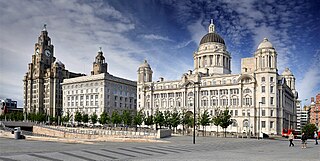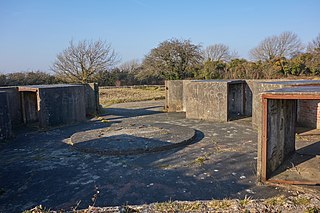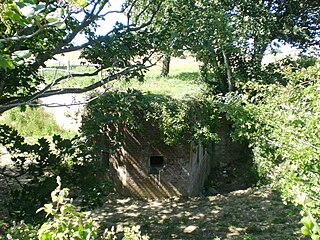
Merseyside is a ceremonial and metropolitan county in North West England. It borders Lancashire to the north, Greater Manchester to the east, Cheshire to the south, the Welsh county of Flintshire across the Dee Estuary to the southwest, and the Irish Sea to the west. The largest settlement is the city of Liverpool.

The Metropolitan Borough of Sefton is a metropolitan borough of Merseyside, England. It was formed on 1 April 1974, by the amalgamation of the county boroughs of Bootle and Southport, the municipal borough of Crosby, the urban districts of Formby and Litherland, and part of West Lancashire Rural District. It consists of a coastal strip of land on the Irish Sea which extends from Southport in the north to Bootle in the south, and an inland part to Maghull in the south-east, bounded by the city of Liverpool to the south, the Metropolitan Borough of Knowsley to the south-east, and West Lancashire to the east.

New Tavern Fort is an historic artillery fort in Gravesend, Kent. Dating mostly from the 18th and 19th centuries, it is an unusually well-preserved example of an 18th-century fortification and remained in use for defensive purposes until the Second World War. It was built during the American War of Independence to guard the Thames against French and Spanish raiders operating in support of the newly formed United States of America. It was redesigned and rebuilt in the mid-19th century to defend against a new generation of iron-clad French warships.

Fort Perch Rock is a former defence installation situated at the mouth of Liverpool Bay in New Brighton. Built in the 1820s to defend the Port of Liverpool, it is now a tourist attraction and museum. It has been used as a venue for musical concerts and has been listed as a Grade II* Listed Building. The Fort's cafe "The Mess" is open daily from 9am. A World War 2 escape room concept "Escape The Fort" runs within the fort.

Hightown is a village and civil parish in the Metropolitan Borough of Sefton in Merseyside, England, located midway between the city of Liverpool and the coastal resort of Southport. It is 8 miles north of Liverpool city centre and is located on the coast near the boundary of the Mersey Estuary and Liverpool Bay. The River Alt joins the sea at this point and forms an estuary. There is a pumping station on the River Alt at Altmouth, built 1972, as part of a programme to alleviate flooding in the area. This is on the Altcar Rifle Range, a Territorial Army base originally established in 1860 by Lt. Col. Gladstone.
Seaforth Battery, Seaforth, Merseyside, England was built to protect shipping on the River Mersey. Constructed as part of the defences of the Mersey Docks, the battery was designed to engage ships using the Rock Channel head on as well as the other shipping channels. The battery supported Fort Perch Rock, which was located opposite on the Wirral bank of the river. It was completed at the end of 1879 at a cost of £19,109.

Seaforth is a district in the Metropolitan Borough of Sefton, Merseyside, England. Historically in Lancashire, it is north of Liverpool, between Bootle and Waterloo.

Crosby Beach is part of the Merseyside coastline north of Liverpool in the Metropolitan Borough of Sefton, England, stretching about 2.5 miles (4.0 km) North-West from the Seaforth Dock in the Port of Liverpool, through Waterloo, where it separates the sea from the Marina. The beach was awarded Keep Britain Tidy's Quality Coast Award in 2011.

Fort Worden Historical State Park is located in Port Townsend, Washington, on 433 acres originally known as Fort Worden, a United States Army Coast Artillery Corps base constructed to protect Puget Sound from invasion by sea. Fort Worden was named after U.S. Navy Rear Admiral John Lorimer Worden, commander of USS Monitor during the famous Battle of Hampton Roads during the American Civil War.

Lavernock Battery was built at Lavernock Point, Wales on the recommendations of the 1860 Royal Commission during the late 1860s to protect the ports of the Severn Estuary. It was replaced by a new anti-aircraft battery during World War II that was equipped with four heavy anti-aircraft guns.

York Redoubt is a redoubt situated on a bluff overlooking the entrance to Halifax Harbour at Ferguson's Cove, Nova Scotia, Canada, originally constructed in 1793. It was designated a National Historic Site of Canada in 1962.

The BL 6-inch gun Mark VII was a British naval gun dating from 1899, which was mounted on a heavy travelling carriage in 1915 for British Army service to become one of the main heavy field guns in the First World War, and also served as one of the main coast defence guns throughout the British Empire until the 1950s.

Yaverland Battery is a battery on the Isle of Wight, United Kingdom. It was constructed between 1861 and 1864.

Fort Nepean is a former defensive facility occupying part of Point Nepean, Victoria, Australia. It was part of a network of fortifications, commanded from Fort Queenscliff, protecting the narrow entrance to Port Phillip. It is now part of Point Nepean National Park and a local tourist attraction.

Breakneck Battery is an artillery battery in the British Overseas Territory of Gibraltar. It is located on Ministry of Defence property at the Upper Rock Nature Reserve, north of Lord Airey's Battery. It is one of a dozen batteries in Gibraltar that had 9.2-inch (233.7 mm) guns installed around the turn of the twentieth century. The emplacement features a 9.2-inch Mark X breech-loading gun on a Mark V mounting. The battery was refurbished by 10 Signal Regiment in 2012 and 2016 whilst being on Ceremonial duties whilst the Gibraltar Regiment where on exercise and is one of three surviving 9.2-inch gun emplacements at the Upper Ridge of the Rock of Gibraltar. By the late twentieth century, the 9.2-inch guns in Gibraltar, Bermuda, Portugal, South Africa, and Australia were the remaining examples of an emplacement that at one point had been mounted at strategic locations across the British Empire.

St. David's Battery, also known during wartime as the "Examination Battery", was a fixed battery of rifled breech-loader (RBL) artillery guns, built and manned by the Royal Garrison Artillery and the Royal Engineers, and their part-time reserves, the Bermuda Militia Artillery and the Bermuda Volunteer Engineers, part of the Bermuda Garrison of the British Army.

The 3-inch gun M1903 and its predecessors the M1898 and M1902 were rapid fire breech-loading artillery guns with a 360-degree traverse. In some references they are called "15-pounders" due to their projectile weight. They were originally emplaced from 1899 to 1917 and served until shortly after World War II. These 3-inch guns were placed to provide fire to protect underwater mines and nets against minesweepers, and also to protect against motor torpedo boats. In some documentation they are called "mine defense guns". The 3-inch guns were mounted on pedestal mounts that bolted into a concrete emplacement that provided cover and safety for the gun's crew.

Fort Templebreedy, also known as Templebreedy Battery, was a coastal defence fortification close to Crosshaven, in County Cork, Ireland. Supplementing a number of earlier structures at Fort Camden and Fort Davis, the site was developed between 1904 and 1909 to defend the mouth of Cork Harbour. Used as a coastal artillery position until the 1940s, and as a military training camp until the late 20th century, many of the structures of the 37-acre site were dismantled over time, and part of the complex used as a pitch and putt course. In 2009, Cork County Council added the site to a proposed list of protected structures – though as of 2020 it remains in the ownership of the Department of Defence.

Raleigh Battery is a former coastal artillery battery, built to defend the Royal Naval Dockyard at Devonport.

The 1st Lancashire Artillery Volunteers, popularly known as 'Brown's Corps', was an auxiliary unit of the British Army raised in Liverpool in 1859. As the Lancashire & Cheshire Royal Garrison Artillery in the Territorial Force it was responsible for defending the Mersey Estuary and the coastline of North West England. It was one of the few coast defence units to fire a shot during World War I but also provided personnel for a number of siege batteries that saw action on the Western Front. It continued in the coast defence role during World War II, at the end of which it sent troops to work in the rear areas in Europe. It was reformed postwar but was broken up when the coast artillery branch was abolished in 1956.






















